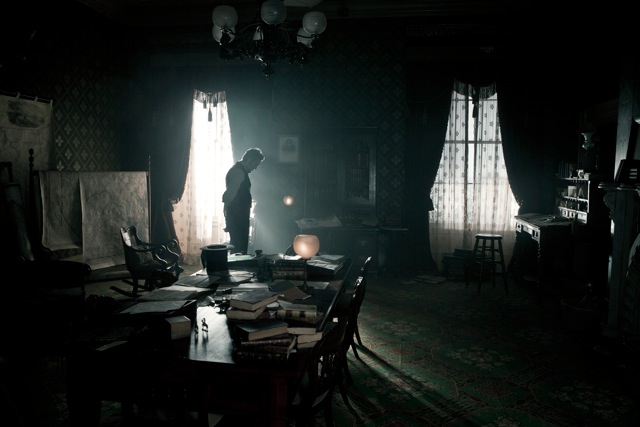Working on a Hollywood film with director Steven Spielberg is a dream for veteran screen actors and those who work behind the scenes to bring the story to life.
When Spielberg selected Richmond and two other Virginia locations to film “Lincoln,” his biopic about the 16th president and his efforts to secure passage of the 13th amendment to the U.S. Constitution that officially abolished slavery, it opened the door for two University of Virginia faculty members to contribute to the production.
Drama professor Richard Warner, who teaches acting in the College of Arts & Sciences, garnered the part of a corrupt Democratic Congressman named Homer Benson and appears in scenes shot at the Richmond Capitol building – transformed into the U.S. Capitol in Washington for the production – and in Petersburg. The experience was a “thrill on all levels,” he said. “It was an opportunity of a lifetime.”
For Leslie McDonald, a 2009 graduate of U.Va.’s master’s of architecture program and currently a lecturer teaching a second-year studio class in the School of Architecture, it was an opportunity to use skills she honed in an earlier career that spanned more than 20 years. As a Hollywood art director and production designer, she worked on such film classics as “Field of Dreams,” “Miller’s Crossing,” “Barton Fink,” “The Hudsucker Proxy,” “Forrest Gump” and with Spielberg on “Minority Report.”
When Rick Carter, the production designer for “Lincoln” who worked with McDonald on “Forrest Gump,” found out she was living in Virginia, he hired her as one of three art directors for the “Lincoln” project.
Also appearing in “Lincoln” was Lance Lemon, a 2011 U.Va. alumnus who played an African-American Union soldier. The Mechanicsville native majored in acting and studio art in the College. In a C-ville Weekly report, Lemon said he’s serious about acting and plans to go to Hollywood.
“Getting to meet Spielberg and getting to talk to him and just seeing how he directs really was an eye-opener for me,” he said. “It raised my expectations.”
McDonald said that when working with Spielberg, “there is a level of research and thoroughness you have to achieve because his expectations are so high. Everything matters to him.”
McDonald and Warner agreed that attention to detail was the work ethic on every level during the production.
For instance, wallpaper in the rooms of the White House were reproductions manufactured by a Richmond company that understood “the hand-printed clay wallpapers” manufactured at the time. The maps used as props in the film were manufactured on muslin and “beautifully printed,” McDonald said – just as they would have appeared on the walls as the Civil War progressed.
A particularly touching theme that runs through the movie is Lincoln’s son Tad’s obsession with glass-plate photos of slaves. Because screenwriter Tony Kushner’s script did not call for scenes depicting slavery, the plates provided a vehicle to show slavery and for Tad to ask questions of Mrs. Lincoln’s seamstress and confidante, a freed slave, about what it was like to be enslaved. “We learn about slavery through the eyes of a child,” McDonald said. “We found historic images to capture the depth of the soul of these people.”
McDonald said her architecture education came into play in shooting White House scenes. At that time, the president’s private quarters were on the same floor as the public spaces. “Understanding the threshold between the two was important. At that time period, the president was so accessible to the public,” she said. “To experience the classical proportions and the relation of public and private space” played a key role visually in the film as Lincoln and others moved from one space to the other.
McDonald said Spielberg relies on the expertise of his
art department for choreography of the scenes. “Spielberg is unique that way,” she said. After setting up a scene, he arrives on set, discusses the action to take place, gets the actors involved and then makes adjustments.
“It keeps it fresh for him – keeps it new and wondrous,” she said.
Warner, who has had roles in other films, including “Toy Soldiers” and “Patriot Son,” praised both Spielberg’s directing style and Kushner’s script. Kushner, he said, developed pieces for the auditions so he could judge who could handle what Warner described as the “sometimes esoteric language” the actors had to master. The screenwriter was present during the filming and “gave us notes about exactly where our characters would be in terms of their motivation.”
Watching Spielberg interact with the actors was a real treat for Warner. “He would get everything ready to go and then focus on you and give you his full attention,” he said.
One day, Warner stood just three feet from Tommy Lee Jones (who portrays Rep. Thaddeus Stevens) as Spielberg spoke with him about one of the scenes in Congress. Warner said it was an “acting coach’s dream of watching a master director talking with a master actor about what he wanted from him.”
Daniel Day-Lewis’ portrayal of Lincoln was also an inspiration, Warner said.
“Talk about an actor possessing a role!” he said. Day-Lewis stayed in character by maintaining the voice he fashioned for Lincoln between takes. Some reviewers have described the voice as weedy and others as high and soft. Warner said when Day-Lewis was “in character, it held the energy for all of us.”
Although the media are different – film and stage – Warner said, “You can bet I am bringing all this back to my classes.”
Media Contact
Article Information
November 29, 2012
/content/uva-faculty-members-alumnus-have-hand-spielberg-s-lincoln

